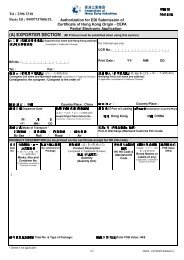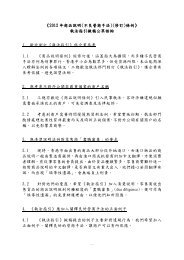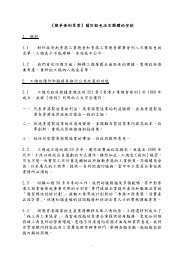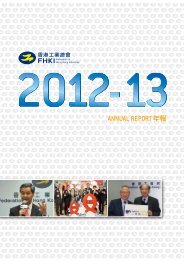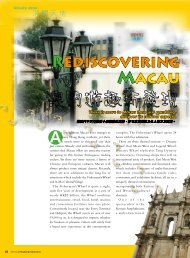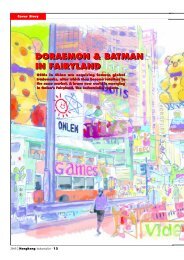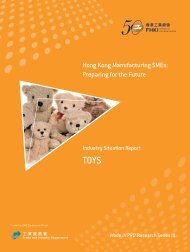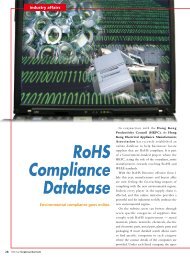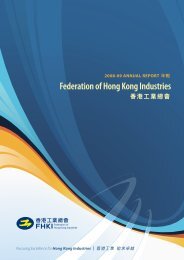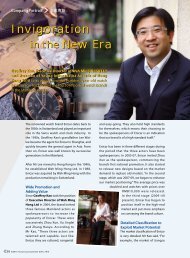Hong Kong Manufacturing SMEs: Preparing for the Future
Hong Kong Manufacturing SMEs: Preparing for the Future
Hong Kong Manufacturing SMEs: Preparing for the Future
- No tags were found...
You also want an ePaper? Increase the reach of your titles
YUMPU automatically turns print PDFs into web optimized ePapers that Google loves.
51factory in Cheung Sha Wan. The company openeda components factory in Dongguan in 2003, butdoes all of its watch assembly in <strong>Hong</strong> <strong>Kong</strong> andSwitzerland. The company has 150 employees in<strong>Hong</strong> <strong>Kong</strong>, 400 employees in Mainalnd China, and25 employees in Switzerland. Roughly 40 per centof revenues come from <strong>the</strong> OEM business, 20 percent from <strong>the</strong> OBM business, and 40 per cent fromretailing. The OEM business is 30 per cent from <strong>the</strong>US, 30 per cent from Europe, and 40 per cent from<strong>the</strong> rest of <strong>the</strong> world. In <strong>the</strong> period 1983 to 2010,Renley’s revenues increased more than twentyfold.Issues and ChallengesRenley has faced a number of significant challengesin <strong>the</strong> course of its history. One has been a seriesof economic downturns. The global economicdownturn associated with <strong>the</strong> dot com collapseand <strong>the</strong> 9/11 attacks affected markets worldwide.During <strong>the</strong> SARS period in 2003, suddenly <strong>the</strong>rewere no customers and no business, but <strong>the</strong> costs<strong>for</strong> rent and staff still needed to be covered. Similarissues arose during <strong>the</strong> global economic downturnof 2008-2009, with business down sharply anduncertain prospects. Fortunately business reboundedin 2010 to more normal levels.Ano<strong>the</strong>r major issue has been competitive pressures.In <strong>the</strong> branded watch business, Swiss and Japanesecompanies are <strong>the</strong> main competitors, but in general<strong>Hong</strong> <strong>Kong</strong> companies can do reasonably well inmoderately-priced branded watches. In <strong>the</strong> OEMbusiness, however, strong competitive pressurecomes from companies that are manufacturing in<strong>the</strong> Chinese Mainland. Customers use quotations<strong>for</strong> contract manufacturing in China to try to obtainlower prices. While producing in <strong>Hong</strong> <strong>Kong</strong> meansthat Renley has not had to face rapidly rising wagesin <strong>the</strong> Pearl River Delta to a great extent, its <strong>Hong</strong><strong>Kong</strong> work<strong>for</strong>ce receives wages on <strong>the</strong> order of threetimes that received in <strong>the</strong> PRD, which has heightened<strong>the</strong> competitive pressures in <strong>the</strong> OEM business.In addition to wages, even finding <strong>the</strong> right workersin <strong>Hong</strong> <strong>Kong</strong> has been a challenge at times inspite of <strong>the</strong> fact that Renley pays comparativelyhigh wages <strong>for</strong> <strong>the</strong> industry. This is due to a generalshortage of workers in <strong>the</strong> industry in <strong>Hong</strong> <strong>Kong</strong>.Not having sufficient workers has made it difficultto expand as quickly as Renley might like and mayeventually make it difficult to continue to producewatches in <strong>Hong</strong> <strong>Kong</strong> if a sufficient number ofworkers cannot be found.Managing cash flow was an early issue <strong>for</strong> <strong>the</strong>company. As a small factory, Renley struggled tocollect cash quickly from its customers in order to beable to pay suppliers and staff in a timely manner.In its first months of operation, Renley focusedon developing <strong>the</strong> documentation and bankingrelations in order to ensure that its trade finance,payments, and receipt system was in place so that<strong>the</strong> company could meet its cash commitments.Ano<strong>the</strong>r challenge in Renley’s early history waswhen a customer that accounted <strong>for</strong> 60 per cent ofRenley’s business ran into difficulty. Renley suddenlyhad to fill <strong>the</strong> gap that was left as <strong>the</strong>ir largestsource of revenue retreated.Expanding into branded watches and retailingalso presented challenges. The branded watchbusiness was unfamiliar to Renley’s management.Renley’s team knew how to make watches, but nothow to manage a brand. Similar difficulties wereencountered when Renley moved into retailing.Some of <strong>the</strong> retail outlets that were set up in <strong>the</strong>early days were in poor locations and <strong>the</strong> companyended up having to close <strong>the</strong>m. The sharp increasein rent in some locations was also unexpected andcreated difficulties. Renley estimates it took threeto five years to work out issues associated with itsinitial <strong>for</strong>ays into branded goods and retailing.



